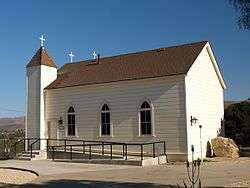Chapel of San Ramon
| Chapel of San Ramon | |
|---|---|
 | |
| Location | Santa Maria, Santa Barbara County |
| Coordinates | 34°50′52″N 120°14′28″W / 34.84784°N 120.24107°WCoordinates: 34°50′52″N 120°14′28″W / 34.84784°N 120.24107°W |
| Official name: Chapel of San Ramon[1] | |
| Designated | January 13, 1975 |
| Reference no. | 877 |
Chapel of San Ramon (also called the Benjamin Foxen Memorial Chapel[2] and the Sisquoc Chapel[3] ) is a chapel and cemetery located in Santa Maria, California in the United States. It is listed on the California Historical Landmarks list and is also the first historic landmark listed by the county of Santa Barbara.[4] It is considered a quality example of "the transition between the architecture of the old missions and the frame churches of the American settlers."[1] It is also one of the first Catholic churches in Santa Maria Valley.[4]
History
The property where the chapel reside was owned by the United States Government as of 1872. That year, Frederick and Ramona Foxen Wickenden purchased it. The couple donated the land to be the site for the chapel and a cemetery.[2] The chapel was built in 1875.[1] Prior to it being built, Frederick Wickenden sold 5,000 sheep to buy redwood to build the chapel. Wickenden, his brother Thomas, and Chris Clausen built the chapel. In 1876, the first burial was made in the cemetery, that of Benjamin Foxen, who was related to the Frederick Wickenden. In 1879, the chapel is dedicated by Francisco Mora y Borrell on behalf of Saint Ramon. In 1908, the chapel joined the Parish of Saint Mary. Regular services were canceled that year, and the church was used only for special occasions. In 1936, the chapel receives a new roof and paint. R.E. Easton rededicates the building.[2]
In 1950, the Native Daughters of the Golden West declared the chapel as their own historic landmark and called it "Benjamin Foxen Memorial Chapel." Eight years later, the chapel is renovated by Winston Wickenden. He replaced the original foundation, made of wood, with concrete. Then renovations are completed in 1959.[2] In 1966, it was named the first historic landmark listed by the county of Santa Barbara.[2][3]
Contemporary times
The chapel began to suffer from frequent vandalism and also had structural problems. In 1972, the San Ramon Preservation group was formed to help protect the property from additional vandalism.[2] In January, 1975, the chapel was named to the California Historical Landmarks list.[1] A dedication ceremony was held in August and mass is held by Father Bertin Foxen. Foxen was the great grandson of Benjamin Foxen. December of that year, a gate is installed at the entrance to the grounds and is dedicated as the John W Woolsey Memorial Gate. The organizing body that maintains the property and building, the San Ramon Chapel Preservation Committee (SRCPC) became a non-profit in 1976. Mass begins again weekly in November. Two years later, in 1978, the chapel receives a new roof and glass windows.[2]
A new foundation is installed in 1983, and additional renovations take place totaling $12,154. In 1985, the first electric heater is installed in the chapel. Stations of the Cross are installed on site by Drew Crosby in 1986. The next year, SRCPC offers to turn the property over to the Roman Catholic Archdiocese of Los Angeles. They decline the offer and SRCPC continued to maintain the property. The first water well is installed in 1988. As of 1999, the chapel continued to receive renovations.[2]
References
| Wikimedia Commons has media related to Chapel of San Ramon. |
- 1 2 3 4 "Chapel of San Ramon". Office of Historic Preservation, California State Parks. Retrieved 2014-08-23.
- 1 2 3 4 5 6 7 8 "History". The San Ramon Chapel. Retrieved 24 August 2014.
- 1 2 "Sisquoc Church and San Ramon Chapel Cemetery" (PDF). Santa Barbara County Planning. Santa Barbara County. Retrieved 24 August 2014.
- 1 2 Carina Monica Montoya (2011). Santa Maria Valley. Arcadia Publishing. p. 12. ISBN 978-0-7385-8880-3.